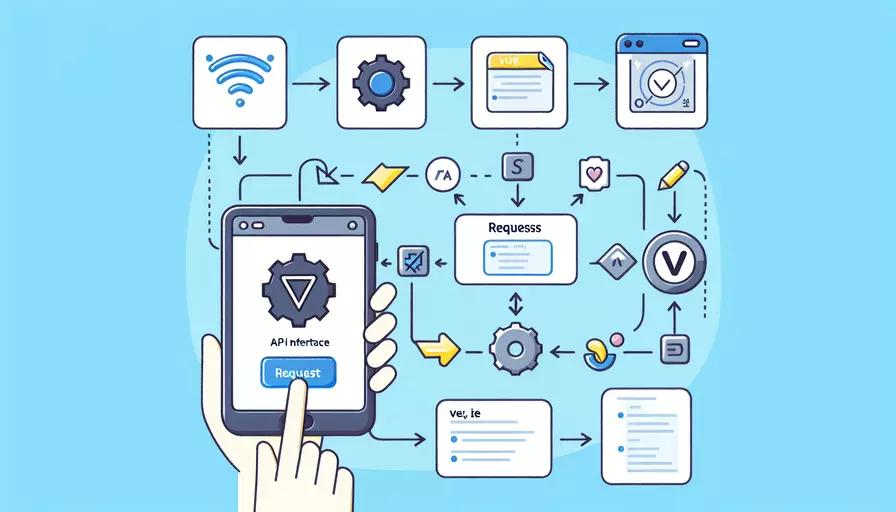
Vue在请求接口时,可以使用以下几个步骤:1、使用Axios库;2、在组件的生命周期方法中发起请求;3、处理请求的响应数据和错误。 Vue.js是一个用于构建用户界面的渐进式框架,通过使用如Axios这样的第三方库,可以轻松地在Vue组件中发起HTTP请求。接下来,我们将详细介绍如何在Vue项目中请求接口,并处理响应数据。
一、使用Axios库
要在Vue项目中请求接口,首先需要一个HTTP客户端库。Axios是一个基于Promise的HTTP客户端,非常适合与Vue.js配合使用。
-
安装Axios
npm install axios -
在Vue组件中引入Axios
import axios from 'axios'; -
配置全局Axios
可以在Vue的main.js文件中配置全局的Axios实例,以便在整个项目中使用。
import Vue from 'vue';import axios from 'axios';
Vue.prototype.$axios = axios;
二、在组件的生命周期方法中发起请求
在Vue组件中,可以在生命周期方法中发起HTTP请求,例如 created() 或 mounted() 方法。
-
在created()中请求数据
export default {data() {
return {
info: null
};
},
created() {
this.fetchData();
},
methods: {
fetchData() {
this.$axios.get('https://api.example.com/data')
.then(response => {
this.info = response.data;
})
.catch(error => {
console.error('Error fetching data:', error);
});
}
}
};
-
在mounted()中请求数据
export default {data() {
return {
info: null
};
},
mounted() {
this.fetchData();
},
methods: {
fetchData() {
this.$axios.get('https://api.example.com/data')
.then(response => {
this.info = response.data;
})
.catch(error => {
console.error('Error fetching data:', error);
});
}
}
};
三、处理请求的响应数据和错误
在处理HTTP请求时,处理响应数据和错误是非常重要的。可以使用Promise的 then 和 catch 方法来处理成功和失败的响应。
-
处理成功响应
this.$axios.get('https://api.example.com/data').then(response => {
this.info = response.data;
});
-
处理错误响应
this.$axios.get('https://api.example.com/data').catch(error => {
console.error('Error fetching data:', error);
});
-
同时处理成功和错误响应
this.$axios.get('https://api.example.com/data').then(response => {
this.info = response.data;
})
.catch(error => {
console.error('Error fetching data:', error);
});
四、实例说明
为了更好地理解,我们可以通过一个实际的例子来说明如何在Vue项目中请求接口。
-
创建一个新的Vue组件
<template><div>
<h1>API Data</h1>
<div v-if="info">
<p>{{ info.title }}</p>
<p>{{ info.body }}</p>
</div>
<div v-else>
<p>Loading...</p>
</div>
</div>
</template>
<script>
import axios from 'axios';
export default {
data() {
return {
info: null
};
},
created() {
this.fetchData();
},
methods: {
fetchData() {
axios.get('https://jsonplaceholder.typicode.com/posts/1')
.then(response => {
this.info = response.data;
})
.catch(error => {
console.error('Error fetching data:', error);
});
}
}
};
</script>
-
运行项目并查看效果
通过以上代码,运行Vue项目后,你应该能够看到从API中获取的数据。
总结
通过使用Axios库,并在Vue组件的生命周期方法中发起请求,可以轻松地在Vue项目中请求接口和处理响应数据。1、安装并引入Axios库;2、在组件的生命周期方法中发起HTTP请求;3、处理响应数据和错误,是实现这一功能的关键步骤。为了确保代码的健壮性,建议在实际开发中对错误处理进行更全面的考虑,例如添加用户友好的错误提示和重试机制。
相关问答FAQs:
1. 如何在Vue中发送HTTP请求?
在Vue中发送HTTP请求可以使用Axios库来实现。Axios是一个基于Promise的HTTP客户端,可以用于发送GET、POST、PUT、DELETE等不同类型的请求。首先,你需要在项目中安装Axios,可以通过npm或者yarn进行安装。
安装完成后,你可以在Vue组件中使用Axios来发送请求。以下是一个简单的示例:
import axios from 'axios';
export default {
methods: {
fetchData() {
axios.get('/api/data')
.then(response => {
// 请求成功后的处理逻辑
console.log(response.data);
})
.catch(error => {
// 请求失败后的处理逻辑
console.error(error);
});
}
}
}
在上面的代码中,我们使用axios.get方法发送了一个GET请求,并在请求成功后打印了返回的数据。你可以根据需要使用不同的方法(如axios.post、axios.put等)来发送不同类型的请求。
2. 如何处理异步请求的结果?
在发送HTTP请求时,由于网络延迟等原因,响应结果往往不是立即可用的。在Vue中,我们可以使用async/await来处理异步请求的结果。
首先,我们需要将发送请求的代码封装在一个异步函数中。例如:
import axios from 'axios';
export default {
methods: {
async fetchData() {
try {
const response = await axios.get('/api/data');
console.log(response.data);
} catch (error) {
console.error(error);
}
}
}
}
在上面的代码中,我们使用了async关键字将fetchData函数声明为一个异步函数。然后,我们使用await关键字等待请求返回的结果。当请求成功时,我们可以通过response.data来获取响应的数据;当请求失败时,错误信息会被捕获并打印出来。
3. 如何处理请求的返回结果?
在处理请求的返回结果时,我们通常需要根据返回的数据来更新Vue组件的状态或执行其他操作。
以下是一个示例,展示了如何根据请求返回的数据来更新组件的状态:
import axios from 'axios';
export default {
data() {
return {
data: null,
loading: false,
error: null
};
},
methods: {
fetchData() {
this.loading = true;
this.error = null;
axios.get('/api/data')
.then(response => {
this.data = response.data;
this.loading = false;
})
.catch(error => {
this.error = error;
this.loading = false;
});
}
}
}
在上面的代码中,我们使用了data选项来定义了三个状态变量:data用于存储请求返回的数据,loading用于表示请求是否正在进行中,error用于存储请求失败时的错误信息。
在fetchData方法中,我们首先将loading设置为true,表示请求正在进行中,然后将error设置为null,以清除之前的错误信息。然后,我们使用Axios发送请求,并在请求成功时将返回的数据赋值给data,同时将loading设置为false,表示请求已完成。如果请求失败,我们将错误信息赋值给error,同时将loading设置为false。
通过这种方式,我们可以根据请求的结果来更新组件的状态,并在模板中根据状态的不同展示不同的内容。
文章标题:vue 如何请求接口,发布者:飞飞,转载请注明出处:https://worktile.com/kb/p/3610152

 微信扫一扫
微信扫一扫  支付宝扫一扫
支付宝扫一扫 